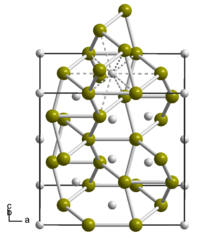
A silicide is a type of chemical compound that combines silicon and a usually more electropositive element.
Silicon is more electropositive than carbon. In terms of their physical properties, silicides are structurally closer to borides than to carbides. Because of size differences however silicides are not isostructural with borides and carbides.
Bonds in silicides range from conductive metal-like structures to covalent or ionic. Silicides of all non-transition metals have been described except beryllium. Silicides are used in interconnects.
Structure
Silicon atoms in silicides can have many possible organizations:
- Isolated silicon atoms: electrically conductive (or semiconductive) CrSi, MnSi, FeSi, CoSi, Cu5Si, (V,Cr,Mn)3Si, Fe3Si, Mn3Si, Mg2(Si,Ge,Sn,Pb), (Ca,Ru,Ce,Rh,Ir,Ni)2Si
- Si2 pairs: U3Si2, hafnium and thorium silicides
- Si4 tetrahedra: KSi, RbSi, CsSi
- Sin chains: USi, (Ti, Zr, Hf, Th, Ce, Pu)Si, CaSi, SrSi, YSi
- Planar hexagonal graphite-like Si layers: β-USi2, silicides of other lanthanoids and actinoids
- Corrugated hexagonal Si layers: CaSi2
- Open three-dimensional Si skeletons: SrSi2, ThSi2, α-USi2
Preparation and reactivity
Most silicides are produced by direct combination of the elements.
A silicide prepared by a self-aligned process is called a salicide. This is a process in which silicide contacts are formed only in those areas in which deposited metal (which after annealing becomes a metal component of the silicide) is in direct contact with silicon, hence, the process is self-aligned. It is commonly implemented in MOS/CMOS processes for ohmic contacts of the source, drain, and poly-Si gate.
Alkali and alkaline earth metals
Group 1 and 2 silicides e.g. Na2Si and Ca2Si react with water, yielding hydrogen and/or silanes.
Magnesium silicide reacts with hydrochloric acid to give silane:
- Mg2Si + 4 HCl → SiH4 + 2 MgCl2
Group 1 silicides are even more reactive. For example, sodium silicide, Na2Si, reacts rapidly with water to yield sodium silicate, Na2SiO3, and hydrogen gas. Rubidium silicide is pyrophoric, igniting in contact with air.
Transition metals and other elements
The transition metal silicides are usually inert to aqueous solutions. At red heat, they react with potassium hydroxide, fluorine, and chlorine. Mercury, thallium, bismuth, and lead are immiscible with liquid silicon.
Applications
Silicide thin films have applications in microelectronics due to their high electrical conductivity, thermal stability, corrosion resistance, and compatibility with photolithographic wafer processes. For example silicides formed over layers of polysilicon, called polycides, are commonly used as an interconnect material in integrated circuits for their high conductivity. Silicides formed through the salicide process also see use as a low work function metal in ohmic and Schottky contacts. High work function metals are often not ideal for use in metal–semiconductor junctions directly due to fermi–level pinning where the Schottky barrier potential of the junction becomes locked around 0.7–0.8V. For this reason low forward-voltage Schottky diodes and ohmic interconnects between a semiconductor and a metal often utilize a thin layer of silicide at the metal–semiconductor interface.
List (incomplete)
- Nickel silicide, NiSi
- Sodium silicide, NaSi
- Magnesium silicide, Mg2Si
- Platinum silicide, PtSi (platinum is actually more electronegative than silicon)
- Titanium silicide, TiSi2
- Tungsten silicide, WSi2
- Molybdenum disilicide, MoSi2
- Neptunium silicide, NpSi2
See also
References
- ^ Greenwood, Norman N.; Earnshaw, Alan (1997). Chemistry of the Elements (2nd ed.). Butterworth-Heinemann. p. 335-336. ISBN 978-0-08-037941-8.
- Schlesinger, Mark E. (1990). "Thermodynamics of solid transition-metal silicides". Chemical Reviews. 90 (4): 607–628. doi:10.1021/cr00102a003.
- Rubidium ampoule opened IN AIR for chemical reactions (Video). ChemicalForce. 22 Feb 2020. Event occurs at 10:51. Archived from the original on 2021-12-21. Retrieved 2020-02-23.
- Murarka, Shayam (1995). "Silicide thin films and their applications in microelectronics". Intermetallics. 3 (3): 173–186. doi:10.1016/0966-9795(95)98929-3. Retrieved 26 July 2023.
- Z. Ma, L. H. Allen (2004). "3.3 Fundamental aspects of Ti/Si thin film reaction". In L.J. Chen (ed.). Silicide Technology for Integrated Circuits (Processing). IET. pp. 50–61. ISBN 9780863413520.
- Monch, W. (1987). Role of virtual gap states and defects in metal-semiconductor contacts. Vol. 58. Physics Review Letter. pp. 1260–1263. doi:10.1103/PhysRevLett.58.1260.
| Salts and covalent derivatives of the silicide ion | ||||||||||||||||||||||||||||||||||||||||||||||||||||||||||||||||||||||||||||||||||||||||||||||||||||||||||||||||||||||||||||||||||||||||||||||||||||||||||||||||||||
|---|---|---|---|---|---|---|---|---|---|---|---|---|---|---|---|---|---|---|---|---|---|---|---|---|---|---|---|---|---|---|---|---|---|---|---|---|---|---|---|---|---|---|---|---|---|---|---|---|---|---|---|---|---|---|---|---|---|---|---|---|---|---|---|---|---|---|---|---|---|---|---|---|---|---|---|---|---|---|---|---|---|---|---|---|---|---|---|---|---|---|---|---|---|---|---|---|---|---|---|---|---|---|---|---|---|---|---|---|---|---|---|---|---|---|---|---|---|---|---|---|---|---|---|---|---|---|---|---|---|---|---|---|---|---|---|---|---|---|---|---|---|---|---|---|---|---|---|---|---|---|---|---|---|---|---|---|---|---|---|---|---|---|---|---|
| ||||||||||||||||||||||||||||||||||||||||||||||||||||||||||||||||||||||||||||||||||||||||||||||||||||||||||||||||||||||||||||||||||||||||||||||||||||||||||||||||||||
| Monatomic anion compounds | |
|---|---|
| Group 1 | |
| Group 13 | |
| Group 14 | |
| Group 15 (Pnictides) | |
| Group 16 (Chalcogenides) | |
| Group 17 (Halides) | |